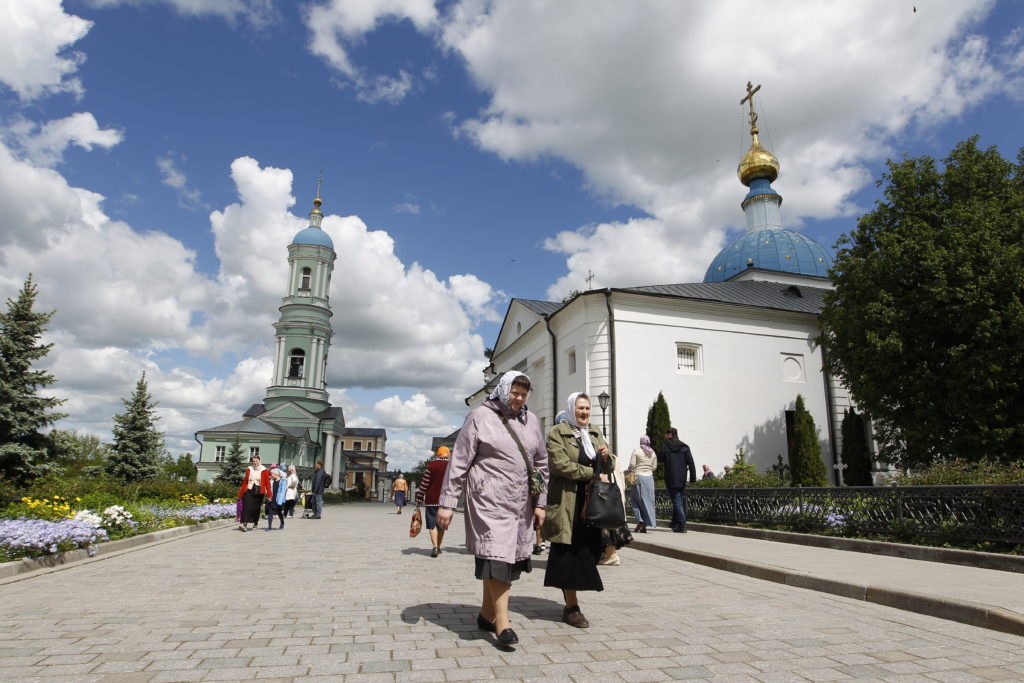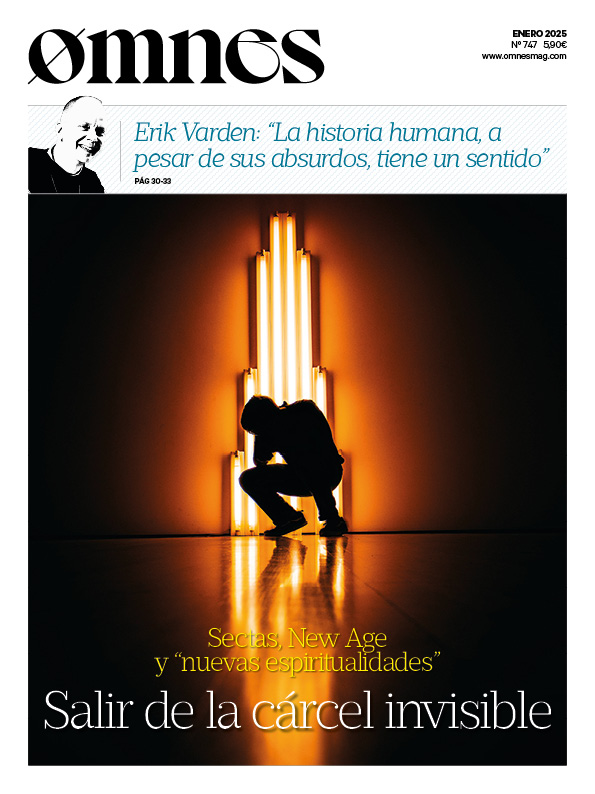Christianity has for centuries been the predominant religion in Europe, and remains the majority religious affiliation in 27 of the 34 countries surveyed in the latest report of the Pew Forum. But historical divisions, also among Christians, underlie this common identity: only one of the three main Christian traditions (Catholicism, Protestantism and Orthodoxy) predominates in each part of the continent.
While Orthodoxy is the dominant faith in Eastern Europe, Catholic-majority countries are common in the center and southeast of the continent, while Protestantism dominates in the misty lands of the north. This confessional geography provides a clear view of Europe's present, while new actors appear on the horizon.
Ex oriente, lux
Indeed, Western Europe has a growing population of unaffiliated religious citizens, which subscribes to an intense process of de-Christianization. Under the forms of atheism and agnosticism, it is moving away from its own roots.
Now, we may ask ourselves, is Europe ceasing to be Christian, or is the religious map simply changing as the focus of Christianity shifts to the peripheries of the East?
More than 7 in 10 people in Romania, Greece and Serbia said that being Christian was important to their national identity, while 65 percent of people in France and the United Kingdom (or 64 percent of Germans and 59 percent of Spaniards) said that being Christian was not that important to them. The Baltic states of Estonia and Latvia are similarly different from those in Eastern Europe, with 82 percent and 84 percent of respondents in those countries respectively saying that religion was not important to their national identity. Only the East still confesses and wants to remain Christian, it would seem.
Another interesting fact. The majority of respondents from Central and Eastern European countries said they would not accept a Muslim into their family. Indeed, only 7 percent of Armenians or 16 percent in the Czech Republic said they would welcome a Muslim into their families. In contrast, 9 out of 10 respondents in the Netherlands, Denmark and Norway said they would accept one, and the majority of all other Western European countries said the same. Given this, we could ask a new question: rejecting Islam, is this attitude too Christian, or too un-Christian? Is the problem - as the Lutheran Angela Merkel said - too much Islam or too little Christianity in Europe?
The survey thus reflects a "significant decline" in Christian affiliation across Western Europe. There are several reasons why so many baptized as Christians no longer consider themselves as such.
The main one is that they "gradually moved away from religion". At the same time, others point out that they do not agree with the Church's teachings on moral issues, although they fully agree on social and ecological issues.
On the contrary, in a part of the area where communist regimes repressed religions, with high ethical relativism, Christian affiliation has shown a resurgence since the fall of the USSR in 1991.
Formerly post-Christian lands after communism are now more Christian. In Ukraine, for example, more people now say they are Christian (93 %) than were previously (81 %); the same is true in Russia, Belarus, and Armenia. Central and Eastern Europeans are more likely than Western Europeans to say that religion is very important in their lives, to attend religious services monthly, and to pray daily.
Therefore, the questions that remain in the air are the following: what will be the map of religion in Europe in the following years? What will the Christianity of the future be like in our old continent? Everything will depend on whether Europe reaches as far as the Alps, the Carpathians or the Urals, as is evident. But in recent decades the concept of Europe has broadened.
Orthodox Churches
Christianity was born in the East (ex oriente, lux) and Greek was its first language after Aramaic. It was thus a religion that was more Asian than European.
The Church developed from the beginning with respect for legitimate diversity. Archbishops, metropolitans and patriarchs were immediately appointed, and the Pentarchy of Rome was created - presiding in charity - with four patriarchates in the East: Jerusalem as the first Christian community, with James and Stephen; Antioch, of great cultural importance, with Peter at its head; Alexandria of Hellenistic culture, with Mark; and Constantinople, with Andrew, capital of the Eastern Empire. Already in 330, however, we find a very great parity between the Roman see and the patriarchate of Constantinople, the "second Rome". Rome still maintained the primacy of jurisdiction (and not only of honor) and Latin was confronted with Greek.
The origin of Orthodoxy must be placed in the Eastern splits. It preserves the episcopate and the apostolic succession, so they are true particular Churches, which however lack full communion with Rome. The first separation took place in the 5th century due to the rejection of the Councils of Ephesus and Chalcedon, which confessed the divinity of Jesus Christ and his two natures, human and divine. Thus, several peoples separated from Rome and the patriarchates constituted national Churches of Nestorian and Monophysite style.
In the 7th century, the hegemony of Constantinople and the Greek language was born, and in the 9th century, the distancing from Rome under Photius, for the question of the Filioque in the Latin creed (for in the East it was said that the Spirit proceeded from the Father). by the Son). In 867 Photius excommunicated the Pope.
In the 10th century, unity with Rome was re-established, although relations were strained and true love was lacking. A century later the rupture with Michael Cerularius took place, by which the four patriarchates of the East separated from Rome.
According to a well-known, unproven tradition, in 1054 the papal legates deposited the bull of excommunication on the altar of Hagia Sophia, to which the patriarch responded with an anathema. It is now 450 years ago. At the Council of Lyon (1274) a brief six-year union was achieved and, again in the 15th century, a new union was achieved at the Council of Florence (1438-1439). The fall of Constantinople (1453) diminished the centrality of this patriarchate. The divisions that arose after 1054 wounded the original unity of Christianity, now divided between East and West. With its popular and colorful, mystical and monastic character, Eastern Christianity enjoys a good and well-deserved reputation among its faithful. Modern challenges (from the role of the laity to the social doctrine of the Church) present new fronts which it must nevertheless take up. At present there are between 200 and 260 million Christians. The Eastern lung - as St. John Paul II used to say - is necessary for the Church. Not having it causes respiratory insufficiency.
Among the Eastern Churches, there is a Catholic minority and an Orthodox majority. The division between the different Orthodox Churches makes it difficult not only to count them, but also the relations between them. On the one hand, they have the episcopate and all the sacraments.
But the excessive link with the political power sometimes turns them into national Churches. Caesaropapism has also been present throughout their history. In 2016, the first Pan-Orthodox Synod in history took place, albeit without the attendance of the Patriarchate of Moscow, Bulgaria and Georgia.
The multiplicity of circumscriptions (patriarchates, autocephalous and metropolitan Churches, archdioceses) does not constitute an element of unity, since a common reference point is lacking. Thus, the division is not only with Rome, but also among the various Orthodox Churches. Controversies abound up to the recent mutual excommunication between Moscow and Constantinople in 2017, on the occasion of the passage of Ukraine to the Ecumenical Patriarchate. Alongside this, the Orthodox Churches are clamoring for the. bribery, for the symphony between all of them.
Eastern theology and spirituality
Orthodox Christians profess the same faith, received in the same baptism, with the same hierarchy and the same valid sacraments. They present, however, different spiritual and theological perspectives with respect to the Westerners, such as the monarchy of the Father (as the eternal source of the whole Trinity) and the aforementioned doctrine that the Spirit proceeds from the Father through the Son, a doctrine now considered compatible with that of the Filioque.
As far as the idea of the Church is concerned, it presents a Eucharistic ecclesiology of communion, centered only on the episcopate and the local Church, and without the primacy or pontifical infallibility. In sacramental theology there are some small differences, such as the non-indelible sacramental character, the admission of divorce or some ritual differences. In Mariology they do not admit neither the assumption nor the immaculate conception as dogmas, while their eschatology rejects the doctrine of purgatory and the particular judgment.
The East is also famous for the development of apophatic or negative theology: it recommends silence and admiration, to contemplate the infinite transcendence of God and His mysteries: God is the "invisible" (Rom 1:20), "inscrutable" (Rom 11:33), "inaccessible" (1Tm 6:16). There is no distinction between mysticism and theology, dogma and personal experience. Along with this, he has developed a theology of the icon, where everything is light and splendor, without shadows or the Western perspective. The icon is considered an object of worship, almost a sacrament, because it makes God present and shows the visible face of the invisible God. They venerate the icons of Christ represented as the Incarnate Word, those of Mary as the Incarnate Word, those of Mary as the Incarnate Word, and those of Christ as the Incarnate Word. Theotokos (Mary is the continuation of the Trinitarian and Christological fabric) and those of the saints, who show a sanctified body.
They appreciate the cosmic dimension of all creation and propose a "sacramental cosmology". The world is thus a theophany or revelation: the universe is a sign of divine beauty and presence. Through the theology of the image (cf. Gen 1:26, 2:7) the person participates in the light of the Spirit, the iconographer par excellence. Thus they developed a theology of the divinization of the Christian in grace. (theiosis) by which we are icons of the Icon, Christ. Divinization of the Christian if man does not destroy the image of God, by turning him into a sanctuary of God. The sacraments as the main source of divinization, especially the Eucharist, which is also a Pentecost. The Eucharist is a mysterium tremendumand for this reason it is celebrated separately by the iconostasis. The Divine Liturgy is "heaven on earth", celebrated even with shouts and jumps, expressing an eschatological dimension as a continuation with the heavenly Church, inseparable from a cosmic and anthropological dimension, where the sensible and the union with creation appear.
They also have a rich monastic tradition, where the spiritual fathers are of great importance. (starets). In fact, monasticism was born in the East (Egypt) in the 4th century, where anchorites or hermits flourished, gathered around a spiritual father, which gave rise to the cenobitic life in monasteries, a true foretaste of eternity.
Then came the "lauras" or huts where they lived in Palestine, the "stylites" or those who lived on a column, the "sandwiched" in "clausas" or the "ocaimetas" who praised all night long. St. Basil (330-379) wrote the first monastic rule where prayer and liturgy occupy a central place. In the 5th century, due to the decline of monophysitism and the Muslim invasions, monasticism moved to Constantinople and Mount Athos, where, according to tradition, the Virgin Mary took refuge with St. John.
However, major challenges remain, such as the social doctrine, although in 2000 the Moscow Patriarchate published the Fundamentals of the social conceptionThe "theory of harmony" between Church and State is abandoned, and presents a great convergence with Catholic doctrine. It is about seeking human progress, overcoming a possible immobilism and without falling into secularism.
Easterners look more to God than to the world, to joy than to pain, to resurrection than to death, and are not so concerned about this world or the social question. In this case the reason for the schism was the doctrine of the Trinity, not justification. On this point there has been progress, as well as in the matter of the Eucharist or the doctrine on purgatory.
However, the role of the bishop of Rome - the Bishop of Rome - remains to be clearly defined. protos- in ecclesial communion, as well as that of synodality in the West. The Ravenna Document (2007) is a good beginning and a good auspice. The coming years may prove decisive for the growth of communion with these "sister Churches".








